Our research has shown that the vast majority of astrophotographers use Sony, Nikon and Canon cameras.
But why do so few people use Fujifilm cameras for astrophotography? Can Fujifilm Cameras be used for astrophotography, and if so, which models are best?
In this article we dig into all aspects of fujifilm astrophotography to answer these questions.
Fujifilm Astrophotography Cameras
In order to gain some objective insight into the best cameras for astrophotography, we reviewed over 800 images shortlisted for the Astronomy Photographer of the Year competition over the last six years (2018-2023).
When we look at the most used camera brands, Canon, Nikon and Sony are by far the most used, with Fujifilm in joint fifth just behind Pentax:
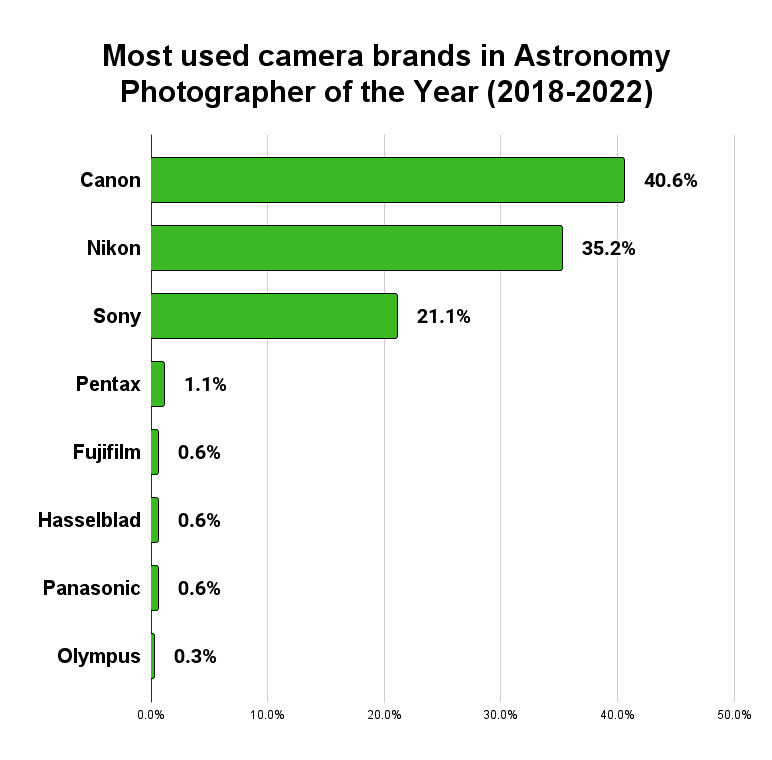
Only two different Fujifilm models have been used in the competition:
- Fujifilm X-T2 – released in 2016 and can only be bought on the used market now.
- Fujifilm X-T4 – released in 2020 and can be bought new or used.
These are both mirrorless cameras, with APS-C sensors.
The reason why Sony, Canon and Nikon camera are preferred for astrophotography – in particular landscape and milky way astrophotography – is that they offer many models with full-frame sensors.
Full-frame sensors are better than APS-C for astrophotography because:
- They perform better in low-light
- They capture a wider expanse of the night sky
(See Full Frame vs APS-C for Astrophotography for more on this.)
Fujifilm only sells cameras with APS-C or medium format sensors, which are less optimal for astrophotography.
However, this does not mean it is impossible to do fujifilm astrophotography and there is plenty of evidence around of people doing this successfully.
In addition, although full-frame is generally regarded as best for astrophotography, it is more than possible with APS-C and this can even be preferred for deep sky imaging, where the cropping results in a narrower field of view and an effective increase of magnification.
Further to this, Fujifilm offers some premium medium format sensor cameras which may, in theory, exceed the performance of full-frame models for night sky photography.
We will look now at the Fujifilm cameras people have been using for astrophotography and examine what evidence of success there has been.
Best Fujifilm Cameras for Astrophotography
Fujifilm X-T4
Best Budget Fujifilm Camera for Astrophotography
The Fujifilm X-T4 is a lightweight, mirrorless camera, with a 26MP resolution APS-C sensor.
It is regarded as a great all-round camera and there is evidence of people using it for astrophotography to great effect.
For example, this Milky Way landscape was taken with a Fujifilm X-T4:
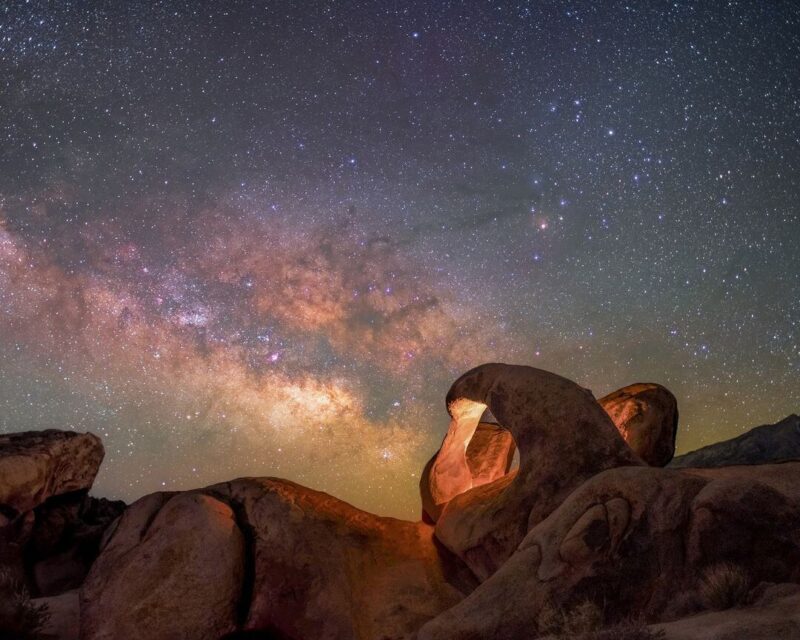
And here’s a star trail image taken with a Fujifilm X-T4:
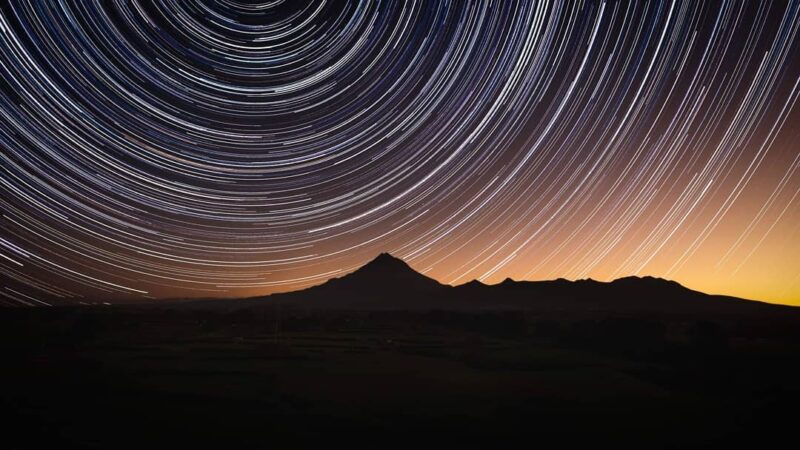
Released in 2020 and weighing just 1.3 lbs (0.6 kg), it has the advantages of a modern mirrorless digital camera.
The 26MP resolution is often regarded as being within a sweet spot where above this higher resolution can result in higher noise (see megapixels and astrophotography).
The camera is in an affordable price range when compared to premium DSLRs and mirrorless models from Fuji and other manufacturers.
These pictures were taken with the Fujifilm X-T3 (the predecessor to the X-T4):
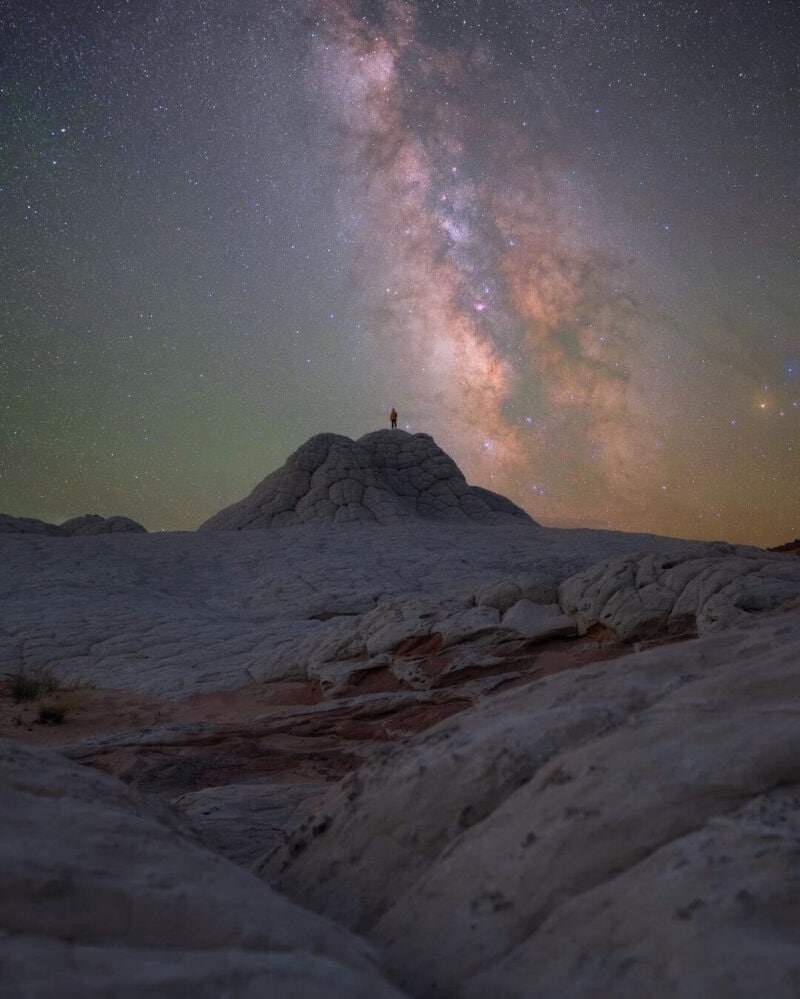

With regards to lenses, there are some perfect X-mount Fujifilm lenses for astrophotography like the Fujifilm XF 16mm F/1.4 and the Fujinon XF18mm F/1.4.
These give you the two key traits of 1) wide-angle and 2) fast aperture that are needed for Milky Way astrophotography.
Fujifilm X-T4 Astrophotography Pros
- Small and light when compared to full-frame cameras
- Wide range of lenses available to fit the Fujifilm X mount
Fujifilm X-T4 Astrophotography Cons
- Relatively expensive for a crop sensor camera
- APS-C sensor limiting for landscape astrophotography
Key specifications
- Camera type: Mirrorless
- Sensor size: APS-C
- Resolution: 26.1 megapixels
- Weight: 1.3 lbs (0.6 kg)
- Year of release: 2020
Overall, this is a great budget option for someone looking for a new Fujifilm camera – and/or an APS-C sensor camera – that can perform for astrophotography.
Mirrorless Digital Camera
- 26.1 Megapixel resolution
- APS-C sensor
- 1.3 lbs (0.6 kg) weight
Fujifilm GFX 100S
High-Resolution Fujifilm Camera
The main selling point of the Fujifilm GFX 100S for astrophotography is the ultra-high 102-megapixel resolution.
There are no cameras from Sony, Nikon or Canon that can rival this if what you are looking for is the highest resolution you can find.
The advantages of a high resolution like this are that:
- You can capture extreme detail even if blowing up the image extremely large
- You can choose to crop into a certain part of what you have captured and extract that as a specific image whilst still maintaining a relatively high resolution.
This second point is what many deep sky astrophotographers do – shoot a wide expanse with a short focal length telescope and high-resolution camera. Then zoom in to a specific astronomical object and crop that as the image.
This has only become possible as camera resolution has got higher – and cheaper – in the past decade or so.
However, there can be downsides to high resolution too. Including:
- Compromised low-light performance. Squeezing more pixels onto a sensor can actually mean that the pixels are smaller and less able to capture light.
- Increased file size. It might not seem like a big issue, but saving all your images at 100MP is going to take a lot of storage
- A higher price (and this camera is expensive)
On the first point tough, due to the medium/large format sensor the pixels are less squeezed than they would be with a full-frame or APS-C sensor. The best measure of this is pixel pitch for which this camera is 3.76 microns which is comparable to that of top full-frame cameras from Sony et all.
This medium-format sensor is rarely favored for astrophotography in comparison to full-frame, or even APS-C, but the main reason for this is cost. There is no inherent weakness for astrophotography with a medium format sensor.
This starry sky photo was taken with a GFX 100S:
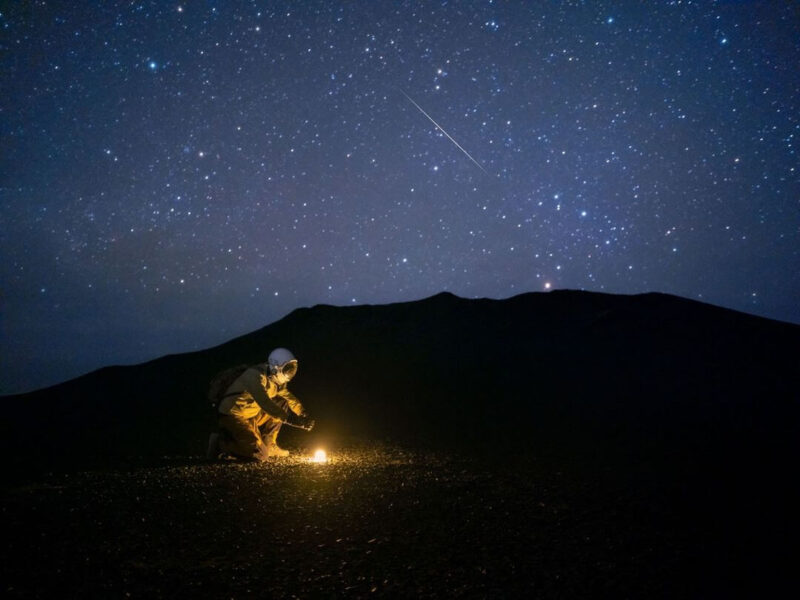
You can also watch this video where this camera is put through its paces for landscape astrophotography:
And this video where it is tested for deep sky astrophotography:
Fujifilm GFX 100S Astrophotography Pros
- Ultra-high 102MP resolution
- Large medium format sensor for good light gathering
Fujifilm GFX 100S Astrophotography Cons
- Price. This camera is top-spec and very expensive
- The high resolution has some downsides for things like storage
- There are a limited number of fast aperture lenses available for the Fuji G-Mount
- Large camera size
Key specifications
- Camera type: Mirrorless
- Sensor size: Medium Format
- Resolution: 102 megapixels
- Weight: 2 lbs (0.9 kg)
- Year of release: 2021
Overall, the reasons to go for this camera are if you want:
- A top-of-the-range Fujifilm for all your photography
- A medium format camera for astrophotography
- More than 100 megapixel resolution
It is expensive though and so while it can definitely perform for astrophotography we believe that you should only go for this camera if you have other purposes in mind or you just really want to see what you can do with medium format astrophotography.
Mirrorless Digital Camera
- 102-megapixel resolution
- Medium format sensor
Fujifilm Astrophotography FAQs
Are Fuji cameras good for astrophotography?
Although less frequently used by astrophotographers than Nikon, Canon or Sony cameras, Fujifilm cameras can be used for astrophotography and have been shown to perform well.
Which Fuji is best for astrophotography?
The Fujifilm X-T4 is a good Fuji camera for astrophotography at an affordable price.
The Fujifilm GFX 100S is a premium option for those that want more than 100 megapixels.
Is the Fujifilm XT4 good for astrophotography?
The Fujifillm X-T4 is good for both landscape astrophotography with a wide-angel lens and deep sky astrophotography with a telescope.
This video from Fujifilm discusses using the X-T4 for astrophotography and the results it can yield:
How do you shoot astrophotography on Fujifilm?
For landscape astrophotography, you are looking to shoot under clear skies, focused on the stars, with the longest exposure time you can before star trailing occurs.
Is Fujifilm good for night photography?
Fujifilm cameras are well-regarded for night photography.
Verdict: Fujifilm Astrophotography
Whilst Fujifilm cameras are not renowned for astrophotography they can be used for either landscape and Milky Way photography with a wide-angle lens, or deep sky astrophotography with telephoto lens or telescope.
If you want a Fujifilm camera for astrophotography then our recommendation is to go for the:
- Fujifilm X-T4 – a great budget option (budget being a relatively term, of course), or the
- Fujifilm GFX 100S – for the premium option with insane resolution
These are great cameras that are extremely popular for other types of photography but there is no reason why they cannot be used for astrophotography.
However, if you are looking to buy a camera specifically for astrophotography then our recommendation is to go for a Sony, Canon, or Nikon with a full-frame sensor.
Full-frame cameras from these brands are proven to a much greater degree for astrophotography and occupy a sweet spot in terms of price to performance.
If this is what you think you might be after then head over to the Best Cameras for Astrophotography to find our up-to-date recommendations.
Please let me know in the comments below if you have any feedback on Fujifilm astrophotography.


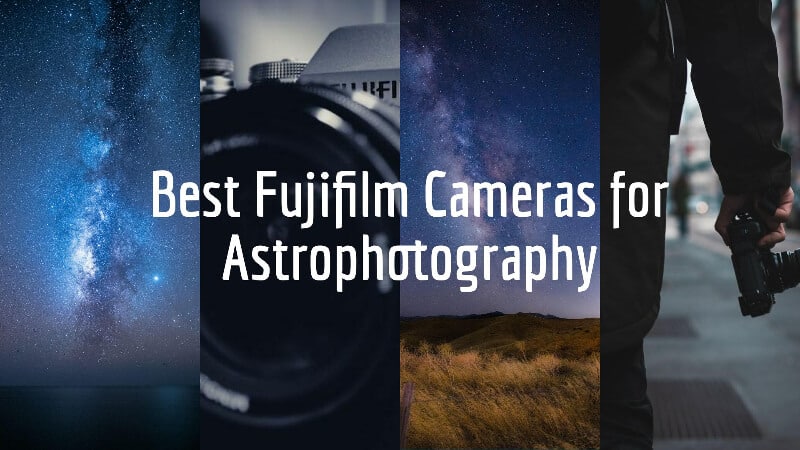



It’s strange that you never mentioned the ability of Fuji’s sensors to capture more REDS from the spectre than any other cameras, which technically makes them perfect for capturing the night sky without even doing any astromodification (which is what most of the astrophotographers do in any case). I’m the happy owner of the X-T3, X-T30-II and X-S10
Thanks Andrei. It does seem that Fuji cameras are quite overlooked by astrophotographers in favor of Nikon, Canon and Sony.
I have had the X-T3 and X-T4, but have gone back to the X-T2 as it has considerably less noise at high ISO levels than the later cameras. I was quite amazed at how much more noise there was on the RAW files from the 26Mp sensor than one that was only 2Mp lower resolution.
Interesting. Thanks Gordon!